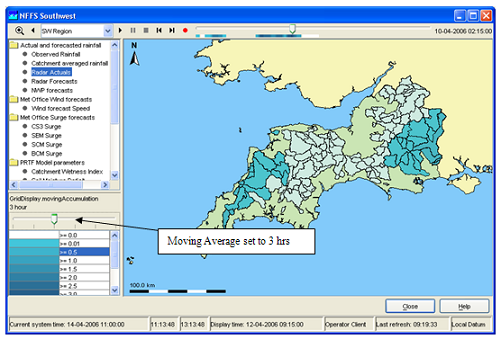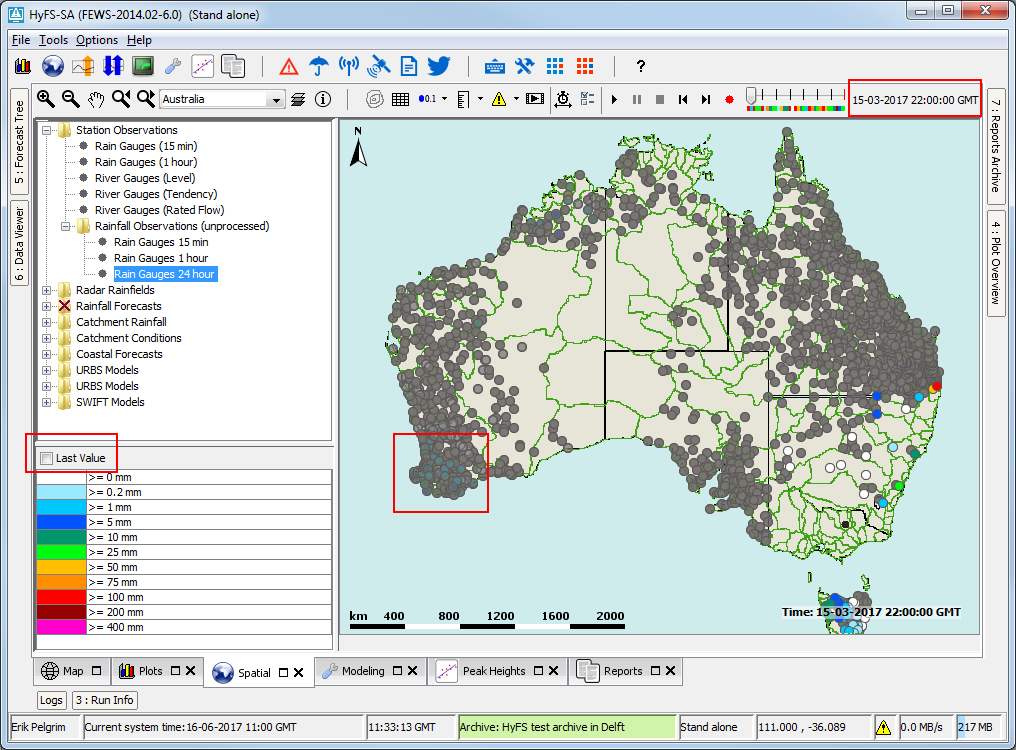...
The spatial display is made up of the following parts:
- A spatial, grid, or map display with layers that you can change
- A Control Toolbar with general options for:
- Zooming in and out and moving around
- Turning map layers or metadata on and off, like labels, values, flags, thresholds, etc.
- A Time Slider Toolbar with general options (found at the bottom of the map since 2019.02):
- Buttons for play, pause, stop, step forward, step backward, and record
- A time slider with a time slice indicator
- An indicator for data availability and maximum value (the colors match the legend)
- Filters for selecting what to show in the Spatial Display (you can set up plots ahead of time)
- A table or bar legend (you can choose to accumulate data)
- Options for exporting or recording data and time series
Control Toolbar
The toolbar offers controls for presenting the spatial information through various buttons. The functionality of zoom options and layers is detailed in the FEWS Explorer section. (see chapter 2).
...
The selection filters indicate which displays have been set up. You can select a filter to show the data. Keep in mind that each grid display might be set up differently, for example, they might show data from different periods, use different background maps, and so on. The configuration allows certain filters to be highlighted in bold.
Locations attribute filter
With the location attribute filters, you can hide one or more locations/grids in the plot. The button ( ) is only visible when attributes are configured for the plot.
Legend
The legend can be
...
displayed as a table
...
or
...
a bar
...
.
...
It identifies the color
...
associated with each range of values.
...
You can rescale the range of values
...
for each color
...
by right-clicking on the display and
...
choosing ‘Rescale Classification’ from the pop-up menu. The display colors will then be updated to
...
match the new classification. After rescaling, the lowest and highest values in the legend will
...
match the minimum and maximum values of the data in the current zoom extent of the display (for the selected time slice).
...
If you zoom in on an area where all data points or grid cells have similar colors, you can use rescaling
...
to better see
...
the differences in
...
data values. To
...
go back to the default classification, right-click on the display and
...
choose ‘Back To Default
...
Classification’ from the pop-up menu. When
...
you select a different plot, the classification always
...
reverts back to the default
...
for that plot.
...
Users can change the classification colors by double-clicking the colored squares in the table legend. These changes are
...
saved in the user settings. If a user has made changes, they can
...
discard them by right-clicking the display and selecting
...
‘Discard User-Defined Classification
...
Colors’.
When
...
multiple classifications are
...
set up,
...
users can select a classification
...
from the drop-down menu located directly above the table legend.
A bar legend displays fluent displays fluent scale bar as shown in the picture below:
Moving Average or Accumulation Slider
The moving average slider can be
...
set up to
...
let the user
...
choose from a number of moving average settings. Each moving average window is then recalculated for the
...
whole period.
...
When you close the program, both the selected grid plot and the
...
chosen aggregation time step are
...
saved in the user settings
...
. When
...
you reopen FEWS, the same aggregation time step will be selected.
...
If you’ve selected an aggregation time step
...
and then switch between different plots, FEWS will
...
try to select the same time step again for the new plot. In the image below, the Moving Accumulation Slider is set to 1 day.
Since the 2023.02 the accumulation slider automatically contains an extra tick at the end of the slider do accumulate the time steps to/from the display time
Last Value Checkbox
When selected this checkbox shows the is selected, it displays the last available of time series configured in the grid plot. This can be useful handy when there are multiple timeseries time series with a different or non-equidistant time step are steps defined within one grid plot, and a time is selected where one time series does not doesn’t have a time step. The time series can be either scalar or grid. For scalars, the last time step (that is still within the visible period) that does not have without a missing value is shown. For grids, but for grids just the last time step is shown, even though if it can might be a missing value. The checkbox will only appear when no neither an accumulation or nor a moving average slider has been configured, and it can be hidden via through configuration. The next screenshots show how data with a daily time step will appear at 22:00 even though it is not defined for that time:
Selecting different forecasts
Selecting different forecast times
...
A “search and select forecast” () button is available
...
. This button
...
becomes active if
...
more than one forecast is available,
...
meaning there are
...
multiple forecast time series with different forecast times
...
in the database and the <numberOfRecentForecasts> is set to more than 1 for the selected grid plot.
...
Clicking the button allows you to cycle through the available forecasts. The drop-down menu will
...
display the forecast times of the available forecasts, and selecting one of these
...
times will
...
change the
...
displayed forecast to the one selected.
Alternatively, you can use the spatial thumbnails
...
to select different forecasts (and
...
different time steps). The spatial thumbnails panel will
...
display one row for each available forecast
...
. You can toggle this panel on or off using
...
the button ( ).
Selecting different ensemble members
Available since 2019.02. The can The button () can be used to open the spatial ensemble thumbnails panel.
The spatial ensemble thumbnails window will open
...
, displaying a thumbnail for each
...
individual ensemble member at the selected time.
In this window
...
, users can
...
choose the
...
ensemble thumbnail
...
they want to view. This selected ensemble member will then be visualized in the grid display.
The ensemble member is
...
identified at the bottom of the thumbnail and
...
in the bottom right corner of the grid display.
The thumbnails can be resized at the bottom right corner of the first thumbnail
...
. A resize mouse cursor will
...
appear when
...
hovering over that corner.
The size will be
...
stored in the user settings
...
for future use.
Contours
The contour button calculates contours on the fly generates contours in real-time for the grids being displayed grids. Since 2021.01 showing contours also works , it’s also possible to show contours for irregular grids and over across multiple grids displayed as the same time. When simultaneously. When the contour button is pressed, bilinear interpolation is used to calculate a value for every each pixel individually. The grid display knows the grid cell for every pixel at the current map extent and zoom level is known by the grid display. The neighbor cell detection of neighboring cells is done at the screen pixel level and works for existing configurations. The interpolation is automatically switched turned off for individual cells that are not rectangular or are rotated more than 10 degrees compared to the screen. The contours are calculated for the interpolated pixel values for the current zoom extent. The contour button is disabled for point data and when contours are configured for a different parameter on top of the parameter that is using the colors from the legend.
Extracting data from the Spatial Display
...
| Info | ||
|---|---|---|
| ||
In 2019.02 the options to extract data from the spatial display were moved from the right-click menu of the map to the drop-down menu of a new button. The options to start drawing profiles or areas, or add points were moved to a new "sketch mode" button. The text below should reflect the location of this functionality from 2019.02 and onward. If you are using an older version that does not have these buttons, all of the mentioned options can be found by right-clicking the map. |
Export time step data in data in ascii grid-file
By right clicking on the display, the grid data for a specific timestep can be exported in an ascii file. Select the desirable time step with the control toolbar.
...

















